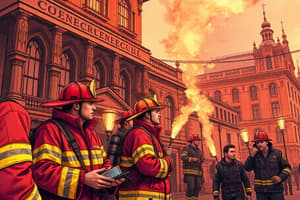Podcast
Questions and Answers
What is the first phase in establishing a union?
What is the first phase in establishing a union?
- Collective bargaining
- Decertification
- Certification
- Organizing of employees (correct)
Which of the following is NOT a component of the Wagner model?
Which of the following is NOT a component of the Wagner model?
- Collective agreement as enforceable contract
- Duty to bargain in bad faith (correct)
- Right of employees to form a union
- Prohibition of unfair labour practices
During the certification process, what does the Labour Relations Board (LRB) confirm?
During the certification process, what does the Labour Relations Board (LRB) confirm?
- The political affiliation of union members
- The industry standards for wages
- The number of employees in the union (correct)
- The duration of the union's charter
What is the result of a successful secret ballot representation vote?
What is the result of a successful secret ballot representation vote?
In the event of decertification, what happens to the union's bargaining rights?
In the event of decertification, what happens to the union's bargaining rights?
Which entity is responsible for overseeing certification and decertification processes?
Which entity is responsible for overseeing certification and decertification processes?
What is a primary objective of collective bargaining?
What is a primary objective of collective bargaining?
What process must union organizers undergo to pursue certification?
What process must union organizers undergo to pursue certification?
What is the primary purpose of the grievance process in a collective agreement?
What is the primary purpose of the grievance process in a collective agreement?
How is a strike voted on according to the procedures outlined?
How is a strike voted on according to the procedures outlined?
What can employers do without a vote during a lockout?
What can employers do without a vote during a lockout?
Which action is prohibited for strikers during a strike?
Which action is prohibited for strikers during a strike?
What is the definition of essential services in the context of strikes?
What is the definition of essential services in the context of strikes?
Under what condition are employers required to vote before locking out workers?
Under what condition are employers required to vote before locking out workers?
Which of the following actions must unionized workers take to initiate a strike?
Which of the following actions must unionized workers take to initiate a strike?
What is true regarding the costs associated with the grievance process?
What is true regarding the costs associated with the grievance process?
What is the first step in the collective bargaining process?
What is the first step in the collective bargaining process?
What is required of both parties during the bargaining process?
What is required of both parties during the bargaining process?
What can either party do if bargaining breaks down?
What can either party do if bargaining breaks down?
What is the primary focus of many disputes related to unfair labour practices?
What is the primary focus of many disputes related to unfair labour practices?
What does a collective agreement typically include regarding disputes?
What does a collective agreement typically include regarding disputes?
What does the term 'peace obligation' mean in the context of collective agreements?
What does the term 'peace obligation' mean in the context of collective agreements?
What occurs after a tentative agreement is reached between the union and employer?
What occurs after a tentative agreement is reached between the union and employer?
What happens if employees reject a tentative collective agreement?
What happens if employees reject a tentative collective agreement?
Flashcards are hidden until you start studying
Study Notes
Collective Bargaining Process
- Notice of intent to bargain must be served by either the union or employer.
- Parties are obligated to commence bargaining upon notice.
- There exists a duty to "bargain in good faith."
- If negotiations falter, either party can request a mediator from the Labour Relations Board (LRB) or initiate job action.
- Voluntary arbitration can be pursued if both parties consent.
Unfair Labour Practices
- Many disputes stem from allegations of unfair labour practices.
- Employers are prohibited from actions intended to harm the union or breach negotiated agreements.
- The burden of proof generally falls on the complainant.
Collective Agreements and Dispute Mechanisms
- Collective agreements contain dispute resolution mechanisms for disagreements between parties.
- Certification bars and collective bars restrict when a union can be raided.
- Peace obligations mandate no strikes or lockouts during the agreement's term.
Key Features of Collective Agreements
- Written contracts detailing terms and conditions of employment.
- Represent all employees within the bargaining unit, defining employer management and operations.
- Establish frameworks for dispute resolution, ensuring workplace rules are adhered to during the agreement's term.
Ratification of Agreements
- Tentative agreements initiate the ratification process involving employee votes.
- A rejected agreement leads to renewed bargaining.
- Accepted agreements are signed, submitted to the LRB, and become binding contracts.
Historical Context
- In 1925, provincial governments were empowered to regulate labor and employment.
- From 1943, the Wagner Act model became foundational for modern labor law.
Components of the Wagner Model
- Right for employees to form or join unions.
- Duty to engage in good faith bargaining.
- Prohibition against unfair labor practices.
- Creation of Labour Relations Boards as administrative bodies.
- Enforceable collective agreements and rules governing strikes and lockouts.
Phases of Union Establishment
- Union establishment involves three key phases: employee organizing, certification, and collective bargaining.
Certification Process
- Union organizers must demonstrate minimal support before applying to the LRB for certification.
- The LRB assesses appropriateness of the bargaining unit and confirms employee count.
- A secret ballot vote determines certification outcome.
Decertification
- The process for a union losing its bargaining rights mirrors the certification procedure.
Grievance and Arbitration
- Collective agreements outline grievance processes with multiple steps leading to arbitration.
- Strikes require member voting, while employers can lock out without a vote unless part of an association.
Strike and Lockout Regulations
- Strike votes are governed by strict regulations, requiring secret ballots and majority support.
- Employers typically do not necessitate a vote for lockouts unless unified in associations.
Striking Allowances and Restrictions
- Strikers can withdraw services, communicate messages publicly, and engage in peaceful picketing.
- Strikers are prohibited from entering private property, causing public inconvenience, and assaulting individuals.
Essential Services
- Certain essential services, crucial to public safety and law enforcement, cannot engage in strikes or be locked out.
- The LRB and Minister of Labour hold the authority to designate such services.
Studying That Suits You
Use AI to generate personalized quizzes and flashcards to suit your learning preferences.




